Search the Special Collections and Archives Portal
Search Results
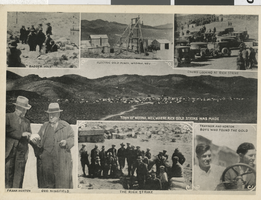
Postcard of scenes in central Nevada, circa 1927-1930s
Date
1927 to 1939
Archival Collection
Description
A picture postcard with photographs with the captions "Badger hole;" "Electric Gold Mines, Weepah, Nevada;" "Crowd looking at rich strike;" "Town of Weepah, Nevada where rich gold strike was made;" "Frank Horton, Geo. Wingfield;" "The rich strike;" "Traynor and Horton, boys who found the gold." Leonard Traynor and Frank Horton, Jr., found gold ore in Weepah, Nevada in early spring 1927; George Wingfield was a prominent banker and miner in Nevada in the early decades of the twentieth century. The "badger hole" was where Traynor and Horton reportedly made their first gold strike.
Image
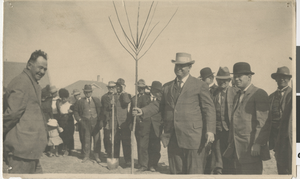
Photograph of people planting first tree in the courthouse park, Las Vegas, March 1911
Date
1911-03
Archival Collection
Description
Black and white photo of people planting the first tree in the courthouse park, Las Vegas, March 1911. Individuals shown are: holding the tree, Judge E. J. L. Taber; with the shovel, Ed W. Clark. Others, left to right: Pete Buol; two men , woman and child, unidentified; James G. Givens, Frank Stewart, Charlie Ronnow, John S. Park, O. J. Van Pelt (partly hidden), unidentified, Harley A. Harmon, Judge Henry M. Lillis.
Image
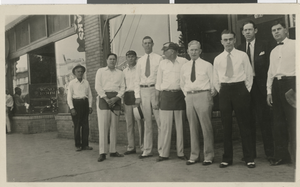
Photograph of dealers from the Rainbow Club, Las Vegas, 1930s
Date
1930 to 1940
Archival Collection
Description
Black and white photograph of dealers (may be men from Rainbow Club). From left to right: unknown, unknown, unknown, Chew-tobaca Pearson, Frank Belding, Ed White, Bob Buchwald, Sundown Wells, Ted Bruner. On verso: "Geo. Wingfield has made his millions in Nev. in the mining game. At present he is the biggest man in Nev. owning most of the banks, large hotels and interested in practically all the big mines. He is the only man that has made a fortune in the state that keeps it here to build up the state. He is a real man and the big guy of Nev." Photo sleeve contains additional materials.
Image
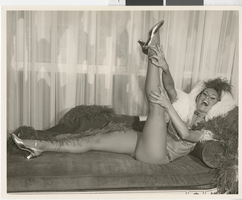
Photograph of Minsky's showgirl posing on a sofa at the Playboy Hotel, Chicago (Ill.), circa 1977
Date
1976 to 1978
Archival Collection
Description
A Minsky's showgirl posing on a sofa at the Playboy Hotel. The Playboy hotel was originally named The Knickerbocker, and has gone through several incarnations since it opened in 1927. Legend has it that in the 1930s the hotel housed a casino frequented by Al Capone. During World War II and the Korean War, US Armed Forces officers would fill the property's hallways and play cards in the Officer's Club. In 1952, Richard Nixon was nominated Vice President during the Republican National Convention held in the hotel. Finally, in the 1970s it became the Playboy Hotel, owned by Hugh Hefner. After completing a multi-million dollar renovation in 2008, the hotel has reinvented itself once again. However, the elegant two-storied lobby still honors the hotel's historic past, with marble ornaments and wood moldings. Site Name: Playboy Hotel (Chicago, Ill.) Street Address: 163 East Walton Place
Image

Photograph of a Minsky's Burlesque showgirl, Playboy Hotel, Chicago (Ill.), circa 1977
Date
1976 to 1978
Archival Collection
Description
A close-up of a Minsky's showgirl posing on a sofa at the Playboy Hotel. The Playboy hotel was originally named The Knickerbocker, and has gone through several incarnations since it opened in 1927. Legend has it that in the 1930s the hotel housed a casino frequented by Al Capone. During World War II and the Korean War, US Armed Forces officers would fill the property's hallways and play cards in the Officer's Club. In 1952, Richard Nixon was nominated Vice President during the Republican National Convention held in the hotel. Finally, in the 1970s it became the Playboy Hotel, owned by Hugh Hefner. After completing a multi-million dollar renovation in 2008, the hotel has reinvented itself once again. However, the elegant two-storied lobby still honors the hotel's historic past, with marble ornaments and wood moldings. Site Name: Playboy Hotel (Chicago, Ill.) Street Address: 163 East Walton Place
Image
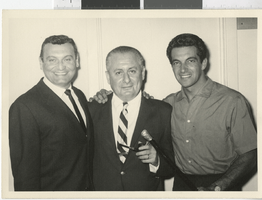
Photograph of Frankie Lane, Harold Minsky, and Frankie Vaughn, Las Vegas (Nev.), 1970-1979
Date
1970 to 1979
Archival Collection
Description
Pictured left to right: Frankie Lane, Harold Minsky, and Frankie Vaughn at the Dunes Hotel. The Dunes Hotel was a hotel and casino on the Las Vegas Strip in Paradise, Nevada, that operated from May 23, 1955 to January 26, 1993. Designed by architect Maxwell Starkman, it was the tenth resort to open on the Strip. Bellagio now stands on the former grounds. The Dunes golf course is now occupied by parts of Monte Carlo, New York-New York, City Center, and Cosmopolitan, and T-Mobile Arena. Site Name: Dunes Hotel and Casino (Las Vegas, Nev.) Street Address: 3600 South Las Vegas Boulevard
Image
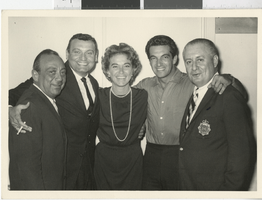
Photograph of Howie Engler, Harold Minsky, and others, Las Vegas (Nev.), 1970-1979
Date
1970 to 1979
Archival Collection
Description
Pictured right to left: Howie Engler, one of the owners of the Dunes hotel; Frankie Lane; Mrs. Frankie Vaughn; Mr. Frankie Vaughn, and Harold Minsky at the Dunes Hotel. The Dunes Hotel was a hotel and casino on the Las Vegas Strip in Paradise, Nevada, that operated from May 23, 1955 to January 26, 1993. Designed by architect Maxwell Starkman, it was the tenth resort to open on the Strip. Bellagio now stands on the former grounds. The Dunes golf course is now occupied by parts of Monte Carlo, New York-New York, City Center, and Cosmopolitan, and T-Mobile Arena. Site Name: Dunes Hotel and Casino (Las Vegas, Nev.) Street Address: 3600 South Las Vegas Boulevard
Image
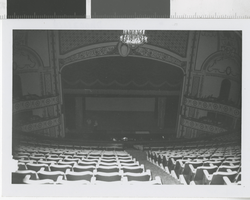
Photograph of the interior of the Shubert Theatre, Cincinnati (Ohio), 1970
Date
1970
Archival Collection
Description
The Shubert Theatre stage as seen from the balcony. Four sections of box seats are visible as well as the orchestra pit. Two unidentified men are on the stage as the screen is being positioned. The 3,000 seat Shubert Theater was built inside what was originally the city’s original YMCA (which opened in 1848). The theater opened in 1921 as a venue for legitimate theatrical performances. The Shubert Theater switched to a combined use venue for movies and stage shows in 1935. The theater was closed in 1953 and reopened as Rev. Earl Ivies' Revival Temple. Just two years later, however, the Shubert Theater was renovated and once again returned to legitimate theater. In 1976, the Shubert Theater was demolished to make way for a parking lot. Today, there is an office building on the site. Site Name: Shubert Theater (Cincinnati, Ohio) Street Address: 90 East 7th Street
Image

Photograph of the interior of the Shubert Theatre, Cincinnati (Ohio), 1970
Date
1970
Archival Collection
Description
The Shubert Theatre stage as seen from the upper house left side of the balcony seats. Two sections of box seats are visible. The intricate wall designs are visible above the box seats and above the exit for the balcony rows. The 3,000 seat Shubert Theater was built inside what was originally the city’s original YMCA (which opened in 1848). The theater opened in 1921 as a venue for legitimate theatrical performances. The Shubert Theater switched to a combined use venue for movies and stage shows in 1935. The theater was closed in 1953 and reopened as Rev. Earl Ivies' Revival Temple. Just two years later, however, the Shubert Theater was renovated and once again returned to legitimate theater. In 1976, the Shubert Theater was demolished to make way for a parking lot. Today, there is an office building on the site. Site Name: Shubert Theater (Cincinnati, Ohio) Street Address: 90 East 7th Street
Image
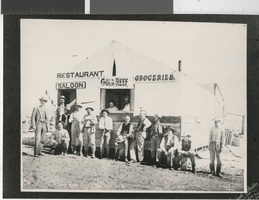
Photograph of people outside Gold Reef's first business (Nev.), 1908
Date
1908-10-11
Archival Collection
Description
Gold Reef, Nevada, camp's first business, October 11, 1908. There is an inscription on the back of the image: "The camp's first business, a combination saloon, restaurant, barber shop and general store, October 11, 1908. Gold Reef was located 8 miles south of Tonopah in the Gold Mountain mining district. The camp was founded after rich gold outcrops were discovered nearby, but the deposits were small and the camp had vanished by 1910. The area came to life again during the Divide boom of 1919, but was abandoned again by 1925. E.W. Smith photo." There is a date stamp: 1984.
Image
Pagination
Refine my results
Content Type
Creator or Contributor
Subject
Archival Collection
Digital Project
Resource Type
Year
Material Type
Place
Language
Records Classification
